Quote:
|
1. The firing pin is not quite inline with primer all the time. The round needs to come out of the magazine and go into the chamber about half way before the primer lines up with the firing pin hole.
|
I agree, unless you put a round in the chamber and drop the bolt! Really what I was thinking of was of the SKS and FAL designs. With these designs the bolt face is at an angle to the cartridge base until lockup. Only when the locking mechanism engages does the breech face rise to perpendicular and the firing pin is in line with the primer.
These mechanisms have slamfires but all the accounts I have seen, they are in battery. Murray’s offers a firing pin spring for the SKS rifle. Besides the benefits he claims, this spring will reduce the impact energy of the firing pin as it rebounds off the firing pin.
http://www.murraysguns.com/sksown.htm
Just look at this insanely dangerous video by Murray. Murray has fixed the SKS firing pin so it is all the way through the bolt face and the SKS goes full auto. The slamfires are in battery due to the titling bolt safety features Sergei Gavrilovich Simonov put in this mechanism. Without them, this rifle would have had an out of battery slamfire. In a Garand type mechanism this would create the perfect conditions for an out of battery slamfire.
http://www.youtube.com/watch?v=xj3QtnUWCwQ
If “high primers” were anything but misdirection, you would expect to find the same percent of out of battery slamfires with AR’s, HK91’s, etc, as you do with Garand mechanisms, and yet, only M1’s, M14’s, M1 carbines, Mini 14’s have out of battery slamfire reports and they have reports of both with factory ammunition. As CCI has said, high primers are the most common cause of misfires! Unless the anvil is firmly seated and the primer cake pushed into the anvil, the primer will misfire.
The best design I have seen to date (I have not seen all!) is the roller bolt mechanism. Vorgrimler designed a very safe and simple mechanism. Based on an examination of this mechanism I cannot see how it could ever have a firing pin induced slamfire. I do not see how it can have an out of battery slamfire as the firing pin cannot protrude through the bolt face until the rollers are in battery. The firing pin spring is extremely stiff, you just have to try to compress it to figure out that firing pin is not going to be floating inside the bolt. To date I have not found one report of a slamfire with this mechanism and I consider that remarkable.
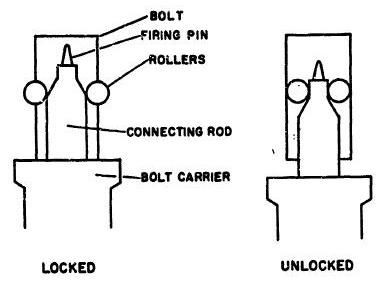
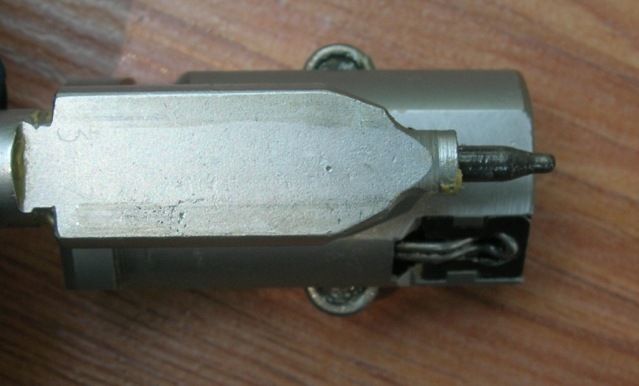
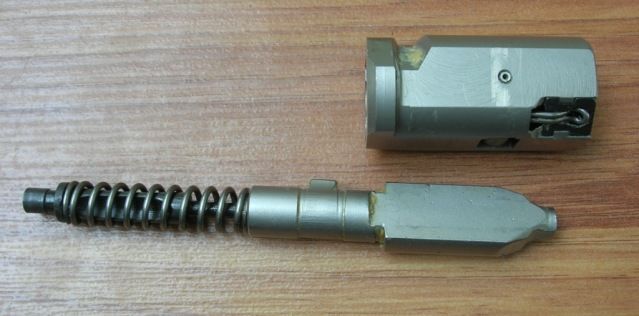
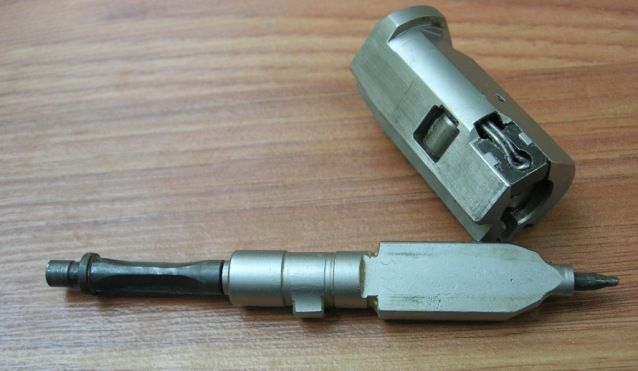
It is apparent that the Garand mechanism slamfired with factory ammunition from its earliest day. This is a picture of the rare round Garand firing pin. This firing pin is rare because it was replaced in the early 40’s and it had to be due to slamfires due to its weight.
The pictures below show the scalloped Garand firing pin, the later M14 firing pin and the M1 Carbine firing pin.

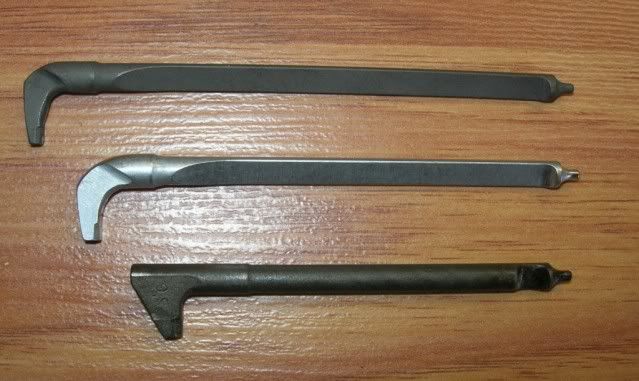
The M1 carbine was the first of its class and if you look at the primer sensitivity of 30 Carbine primers, the average ignition drop height requirement is much higher than that of 30-06 primers. That is why the Army was able to use a heavier round firing pin in the carbine, nether the less, M1 carbines slamfire, and like Garands/M14’s they also slamfire out of battery as well as in battery.
Quote:
|
2. It is a push-feed action. The cartridge stops and the extractor snaps over the cartridge's rim, then the firing pin can reach the primer. This decelerates the bolt gradually and lessens the free floating firing pin's energy.
|
I don’t know how much the extractor decelerates the bolt. It may make a difference but too strong of an extractor and the mechanism would never lock up in battery. I believe adding a firing pin spring, exactly as the Italians did and Roland Beaver does is an excellent idea in reducing the inertia impact of the firing pin. More than any other design, the Garand mechanism relies on primer sensitivity to prevent slamfires as there is not a positive firing pin block in place nor is there anything to prevent the firing pin from touching the primer once the round feeds into the chamber.
Primer sensitivity is very important which is why the military specified less sensitive primers for their mechanism. What makes a “mil spec” primer different from “commercial” primers is that on the average they are less sensitive. Primer sensitivity is a great unknown in the shooting community, but if you spend enough time researching this topic at DTIC you can learn something. By design there are various technics which can make primers more or less sensitive. One of which is the hardness of the cup. This can be seen in this DTIC report: Finite Element Modeling of Primer Impact to Understand the Dynamics of Misfires
http://www.dtic.mil/ndia/2011ballistics/12080.pdf Primer cake is a mixture, the mix of ingredients makes a difference, the type of styphnate used will make the primer more or less sensitive. Federal uses basic styphnate which is the most sensitive of the styphnate isomers, Winchester primers use normal styphnate.
Primers vary by sensitivity by lot and within the lot. There are requirements that primers ignite given certain impact energies, the “all fire” level is the level that all primers must ignite, and there is a “non-fire” limit, a low energy input at which no primer ignites. There are lots of different primers for lots of different devices, they all vary in sensitivity and operational requirements. You can get a good glimpse of what these are in this document: PERCUSSION PRIMERS, DESIGN REQUIREMENTS
http://www.dtic.mil/cgi-bin/GetTRDoc?AD=ADA092511 I have found raw primer data on DTIC and it is absolutely frightening to find primer data that indicates that primers ignite all the way down to the “non-fire” limit. I forget just how many primers, in the data, were tested at the lowest energy input, might have been 30, might have been more, but at least one ignited. There are such things as “overly sensitive” primers and that is something that cannot be detected by visual techniques.
I have found other reports that show that small differences in the amount of primer cake in the cup make a difference in primer sensitivity. Less made the primer more likely to go off, which was counterintuitive. Off center primer hits were less likely to make a primer ignite.
The absolute worst case scenario is a long or tight case with a sensitive primer. This is a perfect storm for an out of battery slamfire in this mechanism. Unlike other mechanisms in which the firing pin is fully retracted before cam down, the Garand mechanism only retracts the firing pin at cam down, and the firing pin is never fully retracted. In my experiments with Garand receivers, there was always some firing pin protraction during cam down.
M14’s have been slamfiring since the day they were made. Estate sales are wonderful things, I have a paper copy of this report. The Army was testing production models of H&R’s and SA’s for dimensional part compliance, (part interchangeability), such things as the thickness of the chrome coatings were measures, rifles were reassembled after gauging and underwent endurance testing.
USATECOM Project No 8F-3002-04, Comparison Test of rifles, 7.62 MM, M14 Manufactured by Springfield Armory and Harrington and Richardson Arms Company. Author G. E. Hendricks, July 1963.
At round 5271 a Springfield Armory M14 went off out of battery, with military ammunition. The report states:
“
One rifle fired when the bolt was in the unlocked position causing breakage for the firing pin, extractor, bolt roller, ejector, and stock. The magazine split, causing the magazine floor-plate spring and 12 rounds of ammunition to be ejected against the bench rest from which the rifle was being fired. The case ruptured and several pieces of brass were found in the area. A broken part of piece of brass perforated a cardboard box with was position between the gunner and the proof director. The cardboard box was used as a brass catcher. Not all the broken pieces were found. Although no one was physically injured this is a seriously unsafe condition.”
Now I am going to ask if the military does not hide its dirty laundry, then why is this 51 year old document not to be found in the public domain?
Quote:
I suppose there are exceptions to every rule.
My "new to me" DCM Garand went grenade on the first trip out, using issue LC69 in a match back in the mid 80's. I had had a couple of "doubles" in the rapid fire strings, and I thouhgt since the gun was new, it was just me and not the gun. After things went south, and my brass was recovered later, those that had doubled, had obviously fired out of battery, as the necks were blown out. Lucky for me, the one that cut loose, was during the slow fire string, and I was single loading
|
I do not understand how or why these mechanisms slamfire out of battery with a factory round in the chamber and yet it happens. I can only guess that this is due to bolt bounce. I can theorize that cartridge binding will create the conditions for out of battery slamfires such as the one described above, which happened as rounds were being fed from the magazine.
I guess my horrible conclusion is that this mechanism will never be perfectly safe. Since the firing pin is never captive and because primers vary in sensitivity, regardless of what you do, there will be in battery and out of battery slamfires. What you can do, and what a reloader should do: Full length size cases and size with a small base sizing die. All sizing dies should be set up with case gauges and the shoulder of the cartridge should be set back at least 0.003", or simply size to gauge minimum. Nothing but the firing pin should hit the primer so all primers must be below the case head, 0.003" to 0.005" is best. Of course you should always use the least sensitive primers in these mechanisms. You should never place a round in the chamber and drop the bolt: always feed from the magazine or SLED. While these practices will reduce the risk of a slamfire to an acceptable level, the risk of a slamfire, based on the design characteristics of the mechanism, will always be there.
I began this journey to understand why the Army Ordnance guidance that "only high primers and worn out receiver bridges cause slamfires" was patently false after my second out of battery slamfire. I knew the Federal primers were below the case head and the receiver NOS. It was from the clip and blew the receiver heel off my rifle. Why these guys lied is very complicated. I believe it might due to the competition between the Colt AR15 and Springfield Armory M14, and I believe the later, when the M1a was the service rifle to use in NRA competition, the NRA authors hide the causes for the same reasons the NFL denigns that concussions cause brain disease.
http://www.pbs.org/wgbh/pages/frontl...gue-of-denial/ Both are/were threats to the sport. It was very unethical not to provide full information to the shooting community about the characteristics of these mechanisms as ignorance leads to property damage and personnel injury. The only ethical action is to inform people about all the measures they should take to prevent slamfires.
I view slamfire deniers in the same way I view people who work for the Tobacco Institute and hand out cigarettes to children. It is not a positive impression.
Still, I continue to shoot my Garands and M1a's in competition, shot two matches in Nov and one in December with a 308 Garand. Because I understand the risks of this mechanism and feel I have done all that is humanly possible to reduce these risks, the probability of a slamfire is acceptable to me.